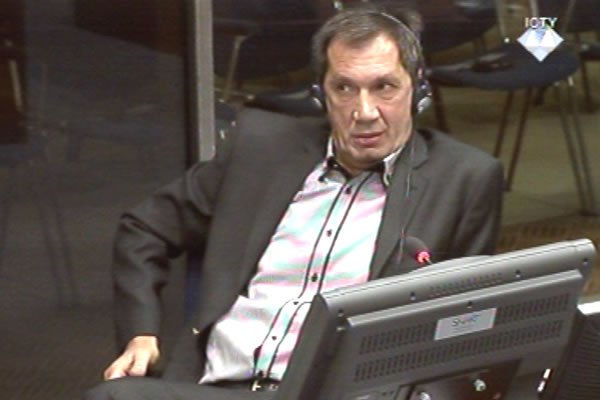Home
‘OUTSTANDING INTELLIGENCE OFFICER’ KNEW NOTHING
Former chief of the Republika Srpska State Security Service Dragan Kijac claimed that he didn’t know anything about the mass executions in the Srebrenica region in July 1995. In fact, as Kijac explained, he had not known about them until 2000. The prosecutor wondered how that was possible, given that at the time of the Srebrenica operation Kijac was the chief of the State Security Service, given that Kijac’s superiors marked him as an ‘outstanding’ intelligence officer and that in 1996, as the Tribunal investigated the Srebrenica massacre, Kijac served as the RS interior minister
 Dragan Kijac, witness at the Radovan Karadzic trial
Dragan Kijac, witness at the Radovan Karadzic trial Former chief of the RS State Security Service Dragan Kijac arrived in The Hague with an alibi. In his statement to Karadzic’s defense, Kijac said that from 14 to 18 July 1995, when the captured Srebrenica men were executed in masses, he was in Montenegro at his deputy’s wedding. It was in that period that the State Security Service received four reports on the situation in the field, the prosecutor said. The reports ‘don’t exist’ anymore and Kijac used that fact to exonerate himself. If there had been ‘something of import’ in the reports, his deputies would surely have informed him about that on his return from Montenegro, Kijac explained.
Prosecutor Melissa Pack noted that the witness had to have at least some knowledge about the killings. By 17 July 1995, the foreign media reported about the thousands of women and children who were deported from the enclave, and about the separation of able bodied men from the rest of the people. Kijac said he didn’t read the reports: first, as he said, ‘I don’t speak English’. Secondly, he lived ‘in special circumstances’ in Pale without water and electricity, and without access to foreign media.
Kijac purportedly didn’t follow the Serbian media either, so he missed the coverage of the events in Srebrenica by the Belgrade journalist Zoran Petrovic Pirocanac. Pirocanac’s report was aired on 17 July 1995 by Belgrade TV network Studio B. This prompted the prosecutor to show Kijac his own report of 21 July 1995 in which he tells Karadzic about the media stories about the region. ‘Based on the coverage of the events in the official media in Serbia, it looks as if the fall of Srebrenica and particularly the deportation of the people had happened on another planet, and for the Politika newspaper, there was no transfer of 23,000 persons…’, he wrote in the report.
Kijac confirmed that the State Security Service did have the information that a number of prisoners had fallen into the hands of the VRS after the capture of Srebrenica, but their number was not higher than 500, nowhere near ‘thousands’. Asked if he meant to say that everybody else knew that the VRS held thousands of prisoners of war and that he knew only about 500 of them, Kijac replied: ‘It would seem so’.
The prosecutor noted that the State Secret Service launched only one investigation related to Srebrenica, against American journalist David Rohde. Rohde’s ‘criminal offence’ was that he found and photographed the mass execution sites in Petkovci and Orahovac.The prosecutor quoted the report in which Kijac wrote that ‘military maps with clearly marked sites where crimes were committed against Muslims’ were found in Rohde’s possession. Kijac explained that Rohde was arrested and prosecuted because he had not been authorized to be in the RS territory.
While the American journalist was prosecuted, in October and November 1995, a secret operation was underway to transfer the bodies of the Srebrenica victims to new mass graves, the prosecutor noted. According to insider evidence, it took hours to move the bodies. Arms and legs fell off the trucks and children would find them by the side of the road, an insider testified. Kijac allegedly didn’t know about that either. Also, Kijac denied that he was involved in the cover-up of the Srebrenica crimes when he ordered, on Petar Salapura’s request, the issuance of false documents to the members of the 10th Sabotage Detachment. Kijac’s purported ignorance of the Srebrenica crimes was such that when he was asked about Branjevo, he said it meant ‘as much to me as the name of a street in The Hague’.
Finally, the prosecutor confronted Kijac with the investigation of the events in Srebrenica conducted by the RS MUP on Karadzic’s request. The investigation report contained two pages. In the only paragraph dedicated to the murders, Kijac concludes that ‘Muslims killed themselves, there was a chain reaction of suicides’. Today Kijac claimed that it wasn’t an investigation but a report sent to the Ministry of Justice, which had just opened a discussion about the events with the representatives of the Tribunal in The Hague.
After Kijac completed his evidence, Karadzic called Boro Tadic, who was a Serb political and military official in Sanski Most during the war. Tadic will continue his evidence tomorrow.Linked Reports
- Case : Karadzic
- 2013-11-29 MEJAKIC: WE WERE ORDERED TO GIVE ‘OFFICIAL VERSION’
- 2013-11-28 PRISONERS NEVER ARRIVED IN BATKOVIC CAMP
- 2013-11-27 ‘UNOFFICIAL’ FORCIBLE EVACUATION
- 2013-12-04 COMPULSORY WORK SERVICE TO MAKE NON-SERBS ‘FEEL USEFUL’
- 2013-12-04 NON-SERBS WERE TREATED ‘PROFESSIONALLY, HUMANELY AND FAIRLY’
- 2013-12-05 ‘VOLUNTARY EVACUATION’ FROM SANSKI MOST AND KLJUC
